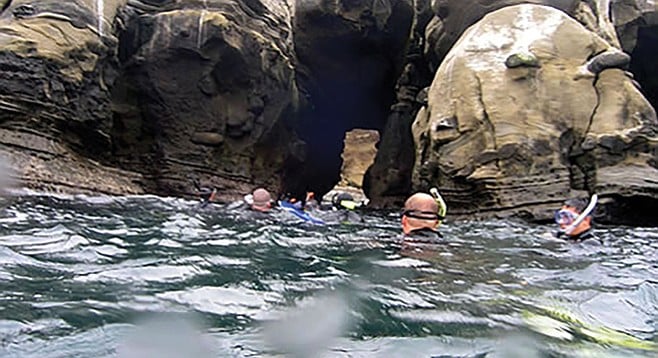 Facebook
Facebook
 X
X
 Instagram
Instagram
 TikTok
TikTok
 Youtube
Youtube

Before World War II there were San Diegans who would feed their families with what they could scratch up from the ocean bottom. This was when few went more than waist deep. The first “goggle swimmers” in our waters could see game fish cruising the reefs and kelp forests along the coast, and fresh fish, lobster, and abalone drew a few people into the sea. To join the San Diego Bottom Scratchers (organized in 1931) you had to dive to 30 feet and bring up three abalone in a single dive; dive to 20 feet and bring up a lobster over three feet long; and bring up a horn shark tail-first. Only nine members made the mark in the club’s first dozen years.
That’s about when my parents started free-diving the La Jolla Cove in the 1950s when equipment was scarce. Dad and mom bought patterns and cut and glued their wetsuits and hit the water with spears in hand.
Those free-diving hunters of broomtail grouper, black seabass, and halibut had to learn the hard way about dive safety. First, they adopted the single-pane glass of the Japanese pearl divers. Then came the fins that gave more speed and agility, and later, the snorkel. Wetsuits allowed more time in the water.
In 1951, the San Diego Council of Divers was founded. The club has initiated safety programs including the Rocks, Rips, and Reefs. The 3Rs is free and open to the public. Experienced snorkelers and swimmers are welcome. The next 3Rs course is this Saturday, July 30, 8 a.m. at Hospital Point in La Jolla.


Before World War II there were San Diegans who would feed their families with what they could scratch up from the ocean bottom. This was when few went more than waist deep. The first “goggle swimmers” in our waters could see game fish cruising the reefs and kelp forests along the coast, and fresh fish, lobster, and abalone drew a few people into the sea. To join the San Diego Bottom Scratchers (organized in 1931) you had to dive to 30 feet and bring up three abalone in a single dive; dive to 20 feet and bring up a lobster over three feet long; and bring up a horn shark tail-first. Only nine members made the mark in the club’s first dozen years.
That’s about when my parents started free-diving the La Jolla Cove in the 1950s when equipment was scarce. Dad and mom bought patterns and cut and glued their wetsuits and hit the water with spears in hand.
Those free-diving hunters of broomtail grouper, black seabass, and halibut had to learn the hard way about dive safety. First, they adopted the single-pane glass of the Japanese pearl divers. Then came the fins that gave more speed and agility, and later, the snorkel. Wetsuits allowed more time in the water.
In 1951, the San Diego Council of Divers was founded. The club has initiated safety programs including the Rocks, Rips, and Reefs. The 3Rs is free and open to the public. Experienced snorkelers and swimmers are welcome. The next 3Rs course is this Saturday, July 30, 8 a.m. at Hospital Point in La Jolla.
Comments